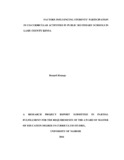| dc.contributor.author | Kisango, Benard | |
| dc.date.accessioned | 2017-01-05T09:10:08Z | |
| dc.date.available | 2017-01-05T09:10:08Z | |
| dc.date.issued | 2016 | |
| dc.identifier.uri | http://hdl.handle.net/11295/99137 | |
| dc.description.abstract | Schools offer after school activities for the benefit of the children. The purpose of the study was to establish the factors influencing students‟ participation in co-curricular activities in secondary schools. The study sought to establish the influence of funding; infrastructural facilities; teachers‟ roles and parental involvement on student‟s participation in co-curricular activities in secondary schools in Lamu County, Kenya. The study used descriptive survey design. The study respondents included principals, teachers and students in secondary schools in the County. A total of 170 students from 17 schools in the County and 17 co-curricular teachers were sampled as the respondents. In addition, three randomly selected secondary school principals acted as key informants in the study. Data was collected using questionnaires from the three different types of respondents. The data analysis included both qualitative and quantitative methodologies. Content analysis was used to analyze the qualitative responses, while descriptive statistics was used to analyze quantitative data. Use of computer aided tools of SPSS helped in hypotheses testing. The researcher believed that the present study will encourage students to introspect and find out their innate co-curricular activities. The findings indicated that 60 percent of students stated that funding for co-curricular activities was inadequate which affected their participation in games and sports. 71 percent of students felt that there were no adequate co-curricular infrastructural facilities in their schools. 76 percent of students thought that there was no positive parental involvement in co-curricular activities. The research had the following recommendations: Each of the co-curricular activity should be bought and adequately funded to ensure that all students have an opportunity to participate; The curriculum for teacher training should include professionalism in co-curricular activities; Parents should be sensitized in identifying, nurturing and developing their children‟s co-curricular activities; career guidance on co-curricular activities to talented and gifted children be offered regularly in the school. The researcher recommended for further research in the following areas: development of children‟ activities from early childhood centers, primary schools and institutions of higher learning; The transition of talented learners from formal schools to professional co-curricular clubs; The operationalization of the Ministry of Education talent centers in Secondary schools. | en_US |
| dc.language.iso | en | en_US |
| dc.publisher | University of Nairobi | en_US |
| dc.rights | Attribution-NonCommercial-NoDerivs 3.0 United States | * |
| dc.rights | Attribution-NonCommercial-NoDerivs 3.0 United States | * |
| dc.rights.uri | http://creativecommons.org/licenses/by-nc-nd/3.0/us/ | * |
| dc.rights.uri | http://creativecommons.org/licenses/by-nc-nd/3.0/us/ | * |
| dc.subject | Students’ Participation in Co-curricular Activities | en_US |
| dc.title | Factors Influencing Students’ Participation in Co-curricular Activities in Public Secondary Schools in Lamu County Kenya | en_US |
| dc.type | Thesis | en_US |



